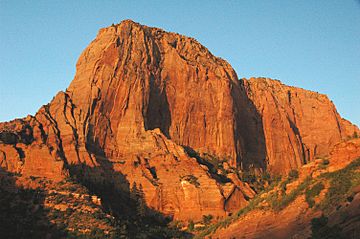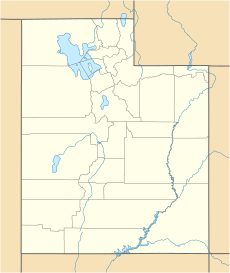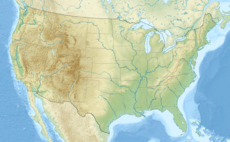Paria Point facts for kids
Quick facts for kids Paria Point |
|
|---|---|

Southwest aspect at sunset
|
|
| Highest point | |
| Elevation | 7,802 ft (2,378 m) |
| Prominence | 82 ft (25 m) |
| Isolation | 1.05 mi (1.69 km) |
| Parent peak | Buck Pasture Mountain (8,030 ft) |
| Geography | |
| Location | Zion National Park Washington County, Utah, US |
| Parent range | Colorado Plateau |
| Topo map | USGS Kolob Arch |
| Geology | |
| Age of rock | Jurassic |
| Type of rock | Navajo sandstone |
| Climbing | |
| Easiest route | class 2 scrambling |
Paria Point is a tall rock formation in Zion National Park, Utah. It stands 7,802 feet (2,378 meters) high. This amazing point is part of the beautiful Kolob Canyons area. It is known for its stunning red rock cliffs.
Contents
About Paria Point
Paria Point is a mountain peak located in the Kolob Canyons part of Zion National Park. This park is found in Washington County, Utah, in the United States. Paria Point is a popular spot for hikers and nature lovers.
Where is Paria Point?
Paria Point has several interesting neighbors. Tucupit Point is about 0.5 miles (0.8 kilometers) to the north. Beatty Point is 0.5 miles (0.8 kilometers) to the south. Between these points are deep canyons, about 2,000 feet (610 meters) deep. Other nearby features include Nagunt Mesa and Timber Top Mountain to the south. Horse Ranch Mountain is located to the north.
How Paria Point Formed
Paria Point is made mostly of a type of rock called Navajo sandstone. This sandstone formed during the Jurassic period, a very long time ago. Below the Navajo sandstone, you can find tilted layers of the Kayenta Formation. Water from rain and snow, called precipitation runoff, flows into Taylor Creek. This creek is part of the Virgin River system.
What's in the Name?
The name Paria comes from the Paiute language. The Paiute are a Native American tribe. In their language, "paria" means "muddy water" or "elk water." This name likely describes the water found in the area.
Climate
The best times to visit Paria Point are during spring and fall. The weather is usually very pleasant then. The area has a Cold semi-arid climate. This means the coldest month has an average temperature below 32 °F (0 °C). Also, at least half of the yearly rain falls in spring and summer.
This desert climate gets less than 10 inches (254 millimeters) of rain each year. Snowfall in winter is usually light.
Gallery











